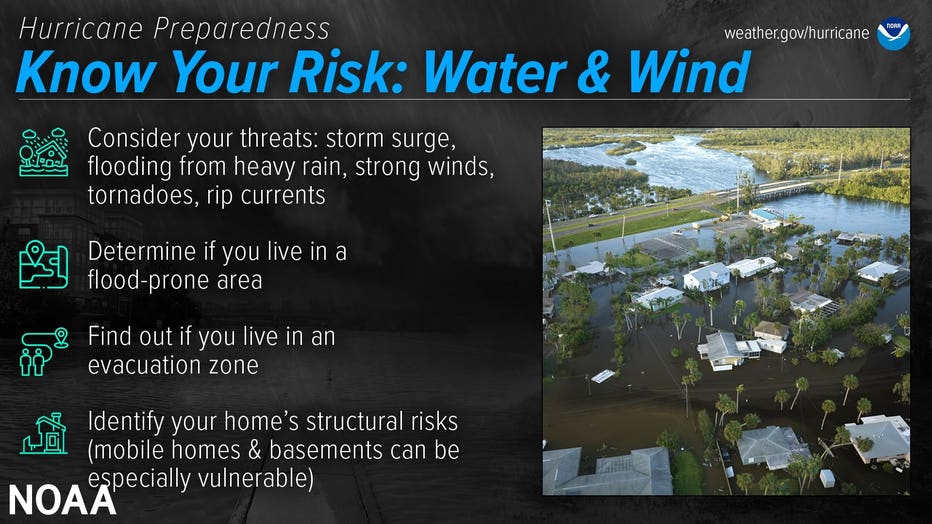Hurricane Preparedness Week: Know your risk for water, wind
Hurricane season preparedness: Fort Bend County leaders launch billboard campaign
Hurricane season preparedness: Fort Bend County leaders launch billboard campaign
HOUSTON - Hurricane season is a month away and it's always better to be prepared than not knowing what to do when disaster strikes. This Hurricane Preparedness week we're giving you information to help you be ready for when natural disaster strikes.
An important thing to know ahead of a hurricane is what type of wind and water hazards could happen in your area as the impact from hurricane winds and water can be felt hundreds of miles inland.
SUGGESTED: Colorado State University hurricane forecast: 2023 outlook released
Here are some things to know from the NOAA about preparing for strong wind, heavy rain, and flooding from hurricanes.

(Image credit: NOAA's National Weather Service)
Consider Your Threats
The primary hazards from tropical depressions, tropical storms, and hurricanes can be storm surge flooding, inland flooding from heavy rains, destructive winds, tornadoes, and high surf and rip currents.
- Storm surge is water that is pushed toward the shore by winds swirling around the storm and historically has caused the largest loss of life in hurricanes. This rise in water level can cause severe flooding in coastal areas, which can submerge entire areas, cause structural damage to buildings, and wash out roads. Storm surge can travel several miles inland, especially along bays, rivers, and estuaries.
- Flooding from the extreme amounts of rain a hurricane can bring has also proven to be very deadly, both over an extended period of time as well as very short-term flash flooding. Homes and businesses could flood, and flooded roads could make travel and evacuations difficult, as well as being a potentially deadly hazard to those in vehicles or on foot. Floodwaters can also contain harmful bacteria, chemicals, wildlife, and other dangerous objects. Extreme rain from hurricanes can even flood areas that aren’t normally prone to flooding. Flooding can happen hundreds of miles inland and can persist for several days after a storm.
- Hurricane-force winds can cause damage to homes and other buildings, ranging from moderate to catastrophic depending on both wind speed and structural integrity. Wind damage can lead to large areas with power and communications outages, as well as uproot trees and make roads impassable due to debris. Signs, roofing material, and other items left outside can become flying missiles during hurricanes. Mobile homes are especially vulnerable to wind damage.
- Hurricanes and tropical storms can also produce tornadoes. These tornadoes most often occur in thunderstorms embedded in rain bands well away from the center of the hurricane; however, they can also occur near the eyewall.
- Waves from distant storms can produce deadly rip currents and rough surf on beaches very far away. Good weather at the beach itself does NOT mean the ocean is safe. Even storms more than 1,000 miles away can cause impacts.
Determine if you live in a flood-prone area
If you live in a flood-prone area, it is especially vulnerable to hurricane impacts. You can find out if you live in an area at risk for flooding using the link below. If you don't live in a flood-prone area, it doesn't mean you're necessarily safe, as heavy rain can bring floods to areas that aren't in a flood-risk area.
Find out if you live in an evacuation zone
Knowing if you live in a storm surge evacuation zone, can tell you how vulnerable you are and will be important when it comes time to develop an evacuation plan.
- HurricaneStrong: Find Your Evacuation Zoneoffsite link
Identify your home’s structural risks
The structure of your home is important for knowing how you can be impacted by winds and water. Some parts of your home can be strengthened while others cannot. Mobile homes are vulnerable to hurricanes and basements are especially vulnerable to storm surge and flooding.

